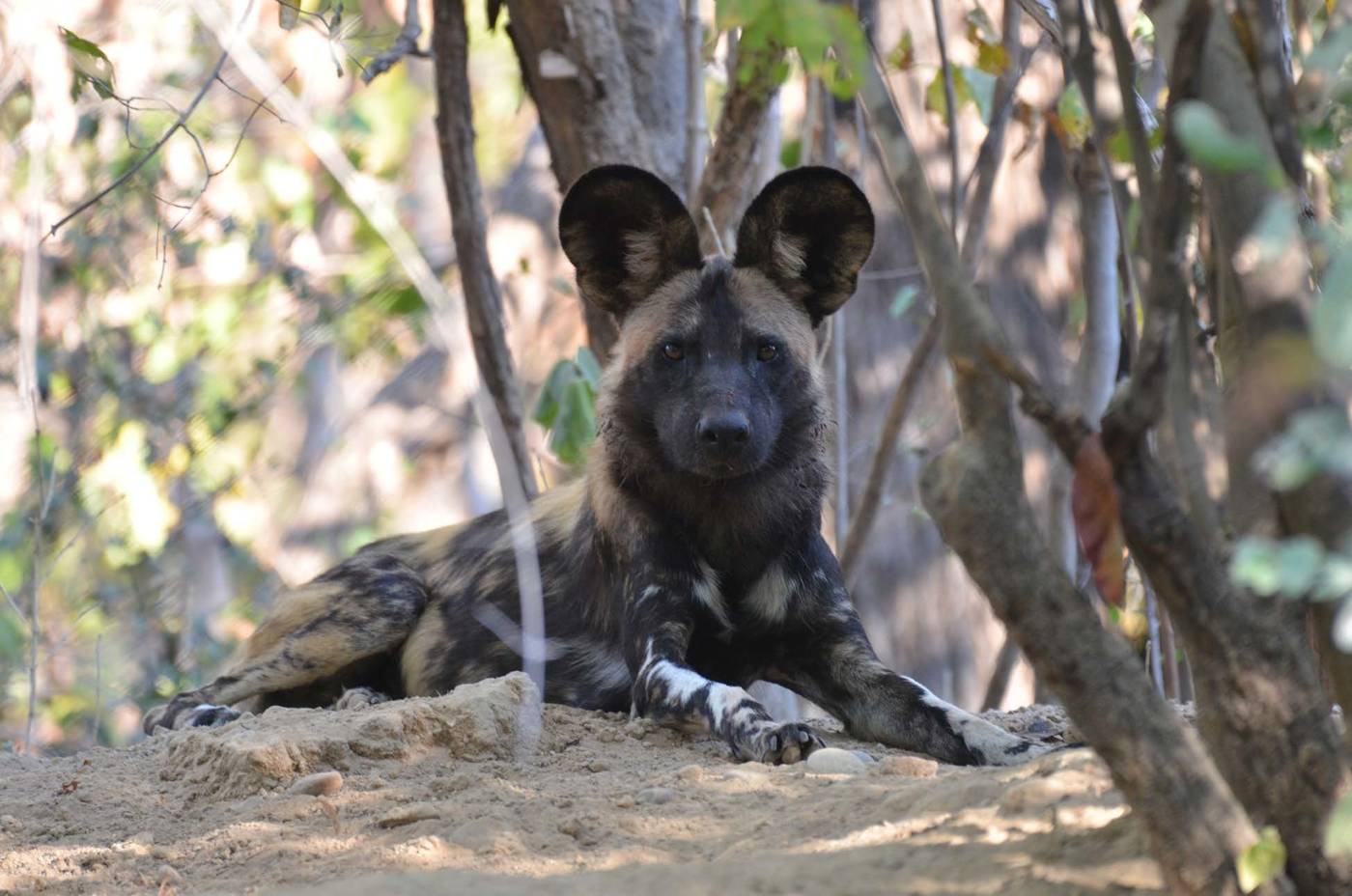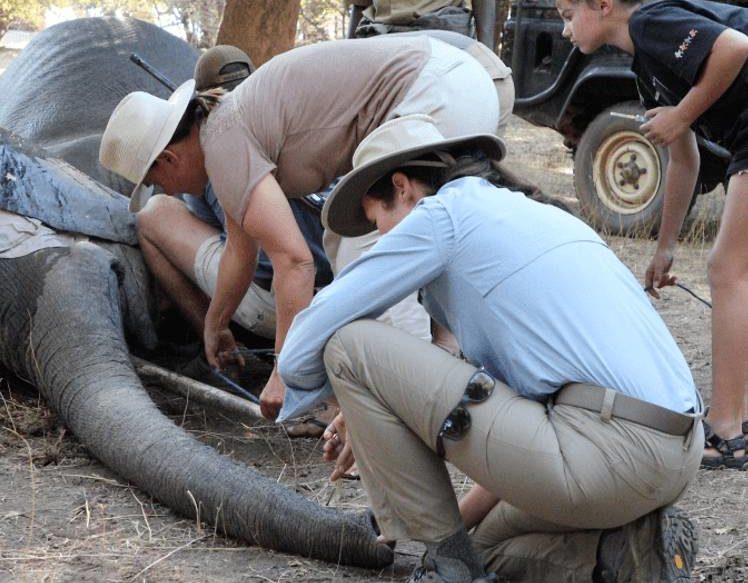Zambezi Network connected with Nick Murray from Bushlife Conservancy, to learn about his conservation journey which led him to assist Zimbabwe Parks and Wildlife Management Authority (ZPWMA) in a number of research projects in Mana Pools and its surrounding areas.

Bushlife Conservancy focuses on the monitoring of wild dog packs in Mana Pools, as well as the collaring and monitoring of elephants and carnivores (Photo: Bushlife website).
Over the past 10 years, safari guide and Bushlife Safaris Managing Director, Nick Murray, has been involved in a number of conservation projects in Mana Pools and the wider middle Zambezi Valley, which subsequently evolved into the establishment of Bushlife Conservancy, a conservation support organisation focusing on Mana Pools and the surrounding areas and communities. The organisation focuses on wildlife conflict mitigation, infrastructure development, anti-poaching support and tracking, and research and monitoring.
Elephant Monitoring Programme (2017 – ongoing)
In 2015, Bushlife Safaris were called on by ZimParks to assist with the Elephant poaching epidemic. The poaching crisis, which saw a massive decline in the elephant bulls in Mana Pools, was further accelerated by commercial trophy hunting activity.
The Elephant Monitoring Programme was launched by ZimParks with the support of Murray and his team in 2017. The project aimed to monitor the behavior and population of the iconic bulls in Mana Pools by collaring, thus satellite tracking selected elephants, and has welcomed both local and international research students to participate. This expensive exercise was supported by donors as well as the support of veterinary support provided by ZimParks Chief Vet, Aware Vets and the Wildlife Unit of Veterinary Services.
Project objectives:
- Monitor movements of elephant bulls to ensure their protection as they move out of the national park into the adjacent hunting areas
- Monitor whereabouts in relation to surrounding communities to mitigate human wildlife conflict
- Gain a better understanding of their overall movements and behaviour
- Ensure their protection against poaching and other threats
- Gain a better understanding of the movement of trophy bulls by comparing their behaviour with younger bulls, as well as cows
Since launching the project, approximately 14 elephant bulls have now been collared, and the project is expanding beyond protection-focused, to general research to gain a better understanding of elephant behaviour and movement in Mana Pools. This includes the collaring and monitoring of some of the herd matriarchs as well as younger bulls, and thus far 16 collars have been fitted.
Bushlife Conservancy continues to support ZimParks ecologists in this ongoing project which has already had an impact in securing the protection of Mana Pools iconic elephant bulls. For example, the famous elephant bull ‘Boswell’ has been identified on three hunts in Nyakasanga in 2021, however has not been shot due to his collar.
The project has slowed down due to the Covid-19 pandemic which posed many challenges. It was also hoped that the project would be complimented by an updated elephant census which was underway in 2020, however put on hold following a tragic accident.

Bushlife Conservancy supported ZPWMA in the launch and implementation of the Elephant Monitoring Programme which kicked off in 2017 and is ongoing (photo: Bushlife website).
Painted Dog Monitoring
Murray has been following the wild dog packs of Mana Pools since he began guiding in the area in 1997. He also became involved in the research and monitoring of these packs, which was spurred by an alarming 60% drop in the population on the floodplain (which accounts for 10% of the National Park). This only came about in 2017 after three productive alpha females died of old age and the packs disintegrated.
Murray says that it became essential to gather scientific data to support the anecdotal evidence and assumptions as to why the wild dog population was rapidly dwindling. “While we had a good sense of why the wild dogs were gathering on the floodplain and under threat, we could not make management strategies and plans to boost wild dog numbers without scientific evidence, especially as the wild dog is an endangered species,” says Murray, who was involved with the project for eight years.
Thus far, the project has largely focused on collecting data on the behaviour of the wild dogs, however more recently there has been a shift to better understand the interspecies interaction and competition with other species, mainly carnivores. This is a response to the obvious predator pressure, with wild dogs being hunted by lions mainly.
“We have frequently found the aftermath of lions killing painted dogs: a dog carcass full of bite marks with lion tracks around the carcass and seeing lions with little pups in their mouths. Predator pressure is tremendous and unrelenting on painted dogs.” (Excerpt from Bushlife Conservancy website: Status report on Wild Dogs in Mana Pools 2020).
Murray hopes to support ZimParks to extend the collaring research of wild dogs as far as Dande East on the Mozambique border, where there are healthy wild dog populations but very little is known about them.
Carnivore Research – Mana Pools and Middle Zambezi (2020 – ongoing)
Initiated in July 2020 at the request of ZimParks, the project includes collaring of lions, leopards, cheetahs and hyenas in Mana Pools to understand their spacio-temporal movements as well as predator impact on the wild dog packs, amongst other objectives.
Objectives:
- Track the predator impact on the population of painted dogs
- Determine accurate counts of carnivores
- Determine the spatial distribution of the different predator groups
- Understand and determine the level of interspecies competition
- Better manage human-wildlife conflict
- Contribute to species and conservation management plans
The project aims to increase the collaring of cheetah and leopard in Mana Pools, as well as extend its research to monitor wild dogs and other carnivores in areas such as Nyakasanga and Chewore, and further afield to Rifa and Dande. Ecologists are especially interested in getting a better idea of the cheetah population in the wider middle Zambezi, considering it is very low in Mana Pools where there are approximately 15 to 20. The project is still in data-collection phase.
In addition to collaring research and monitoring, Bushlife Conservancy offers human-wildlife conflict support in the bordering communities with a vehicle stationed in Nyamakati. Here wild animals such as hyena, elephant, lion, leopard have become an increasing threat to the livelihoods of the community. Bushlife has had success in collaring and relocating a number of animals including lions and leopard, however this is an ongoing challenge as these animals expand their territory into the community area and thus often return after relocation.
All information provided is merely for informational purposes and has been verified to the best of our ability. ZVCN does not intend to endorse any particular conservation entity and only aims to report on their efforts by publishing the information provided to ZVCN. Please notify ZVCN directly regarding any queries or updates regarding the information provided at .
The Zambezi Network aims to keep abreast of research publications and updates regarding the above-mentioned research project.

